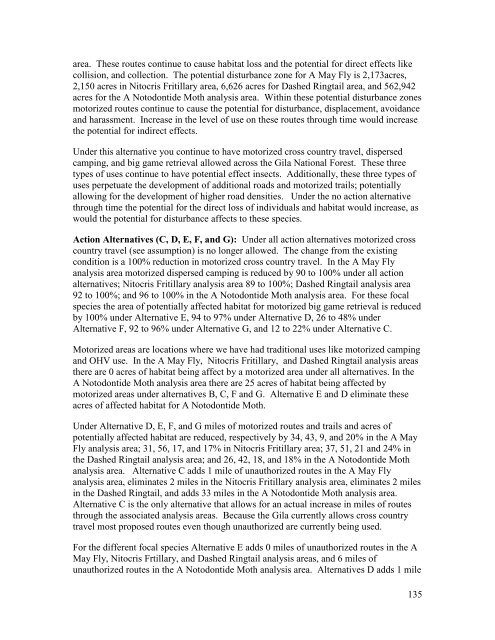Wildlife Specialist report
Wildlife Specialist report
Wildlife Specialist report
Create successful ePaper yourself
Turn your PDF publications into a flip-book with our unique Google optimized e-Paper software.
area. These routes continue to cause habitat loss and the potential for direct effects like<br />
collision, and collection. The potential disturbance zone for A May Fly is 2,173acres,<br />
2,150 acres in Nitocris Fritillary area, 6,626 acres for Dashed Ringtail area, and 562,942<br />
acres for the A Notodontide Moth analysis area. Within these potential disturbance zones<br />
motorized routes continue to cause the potential for disturbance, displacement, avoidance<br />
and harassment. Increase in the level of use on these routes through time would increase<br />
the potential for indirect effects.<br />
Under this alternative you continue to have motorized cross country travel, dispersed<br />
camping, and big game retrieval allowed across the Gila National Forest. These three<br />
types of uses continue to have potential effect insects. Additionally, these three types of<br />
uses perpetuate the development of additional roads and motorized trails; potentially<br />
allowing for the development of higher road densities. Under the no action alternative<br />
through time the potential for the direct loss of individuals and habitat would increase, as<br />
would the potential for disturbance affects to these species.<br />
Action Alternatives (C, D, E, F, and G): Under all action alternatives motorized cross<br />
country travel (see assumption) is no longer allowed. The change from the existing<br />
condition is a 100% reduction in motorized cross country travel. In the A May Fly<br />
analysis area motorized dispersed camping is reduced by 90 to 100% under all action<br />
alternatives; Nitocris Fritillary analysis area 89 to 100%; Dashed Ringtail analysis area<br />
92 to 100%; and 96 to 100% in the A Notodontide Moth analysis area. For these focal<br />
species the area of potentially affected habitat for motorized big game retrieval is reduced<br />
by 100% under Alternative E, 94 to 97% under Alternative D, 26 to 48% under<br />
Alternative F, 92 to 96% under Alternative G, and 12 to 22% under Alternative C.<br />
Motorized areas are locations where we have had traditional uses like motorized camping<br />
and OHV use. In the A May Fly, Nitocris Fritillary, and Dashed Ringtail analysis areas<br />
there are 0 acres of habitat being affect by a motorized area under all alternatives. In the<br />
A Notodontide Moth analysis area there are 25 acres of habitat being affected by<br />
motorized areas under alternatives B, C, F and G. Alternative E and D eliminate these<br />
acres of affected habitat for A Notodontide Moth.<br />
Under Alternative D, E, F, and G miles of motorized routes and trails and acres of<br />
potentially affected habitat are reduced, respectively by 34, 43, 9, and 20% in the A May<br />
Fly analysis area; 31, 56, 17, and 17% in Nitocris Fritillary area; 37, 51, 21 and 24% in<br />
the Dashed Ringtail analysis area; and 26, 42, 18, and 18% in the A Notodontide Moth<br />
analysis area. Alternative C adds 1 mile of unauthorized routes in the A May Fly<br />
analysis area, eliminates 2 miles in the Nitocris Fritillary analysis area, eliminates 2 miles<br />
in the Dashed Ringtail, and adds 33 miles in the A Notodontide Moth analysis area.<br />
Alternative C is the only alternative that allows for an actual increase in miles of routes<br />
through the associated analysis areas. Because the Gila currently allows cross country<br />
travel most proposed routes even though unauthorized are currently being used.<br />
For the different focal species Alternative E adds 0 miles of unauthorized routes in the A<br />
May Fly, Nitocris Frtillary, and Dashed Ringtail analysis areas, and 6 miles of<br />
unauthorized routes in the A Notodontide Moth analysis area. Alternatives D adds 1 mile<br />
135
















